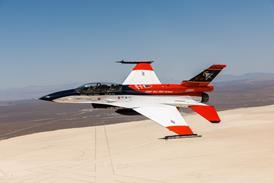US Air Force heralds advent of transformational design that could power service's future long-range strike missions
US Air Force researchers are targeting 2012 to demonstrate "game-changing" adaptive engine technology that will enable combat aircraft to combine high speed with long endurance. The Adaptive Versatile Engine Technologies (Advent) programme aims to develop the capability to vary fan and core airflow and pressure ratio to optimise performance across the flight envelope.
The adaptive engine will be "as dramatic a step as the turbojet to the turbofan", says Jeff Stricker, US Air Force Research Laboratory (AFRL) Advent programme manager. "It will enable us to use aircraft in a different way. A point design will become a multirole aircraft." The USAF's future long-range strike (LRS) platform is one potential application, although an engine using Advent could not enter production before 2018, when the LRS is planned to become operational.
"Today's engines are fixed-cycle, and can provide either fuel efficiency or high performance," says Stricker. The variable-cycle Advent "transcends the two classes - it's a multi-design-point engine providing both high performance and fuel efficiency".
Concept studies are being completed by Boeing, General Electric, Lockheed Martin, Northrop Grumman, Pratt & Whitney and Rolls-Royce Liberty Works. These have identified increases of about 30% in range capability and 70% in loiter duration for a subsonic strike aircraft, and 40% in range and 80% in loiter for a supersonic platform, says Stricker.
Starting with an advanced fuel-efficient engine, Advent overlays adaptive features to modulate the fan and core to match inlet, engine and exhaust mass flows across the flight envelope, reducing overall aircraft drag. In a Mach 2.5 strike aircraft, this would reduce drag per engine by 6% supersonically, 26% transonically and 10-15% subsonically, says Stricker.
The different thrust levels required for supersonic and subsonic cruise would be matched by changing fan pressure ratio and core airflow "rather than throttling the temperatures back", he says, adding: "If we reconfigure the engine, we get around a 35% improvement in specific fuel consumption at subsonic speeds" compared with the baseline Lockheed F-35 Joint Strike Fighter engines.
The AFRL plans to solicit proposals for the Advent demonstrator next month and award contracts to two engine developers by August. Available funding makes it likely only one contractor will be selected to build a demonstrator engine for ground runs in 2012, says Stricker. Development of an Advent-based engine could begin by 2014.
The demonstrator engine is likely to feature two separate fan flowpaths, he says, with an auxiliary fan stream controlled independently to vary mass flow and pressure ratio. There will be some adaptive features in the core, but this technology is "less mature".
Source: Flight International
















